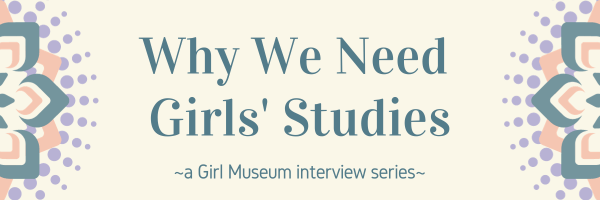
Welcome to Girl Museum’s interview series, Why We Need Girls’ Studies, for 2024. We have many exciting interviews this year with important scholars in the field to get insights about what we are all doing in this space to further our understanding of girlhood and girls’ experiences.
This month’s interview is with Hannah Maitland (she/her), a Ph.D. Candidate at York University who studies girl activists, their politics, and their relationships with their mothers and mother figures. Her other research areas include youth activism, sex education, and sex education controversies. You can find some of Hannah’s writing in the journal Sex Education, Shameless Magazine, and YMCA Canada.

Why do you consider it important to study girlhood?
Girlhood is such a unique stage of life. While it’s interesting in its own right, there is so much cultural anxiety around girls and girlhood that girls are often understood as symbols or representations of social successes and failures rather than actual people. Anita Harris put it well in her 2004 book Future Girl. She describes how girls have been fashioned into the representative symbol of neoliberalism, where they are held to a series of contradictory standards of behaviour and appearance that ask them to not only be hard-working, community-minded, business-oriented, family-focused, and globally informed but to look good and have fun while doing it. There are all these false binaries of authentic/stereotypical, active/passive, and good girls/bad girls, which are so often divided along the lines of race, class, and gender expression, and researching with girls is the only way to engage with the nuances of their actual lived experiences. Girls aren’t just a market niche or problems to solve; they’re members of communities with their own worldviews.
How did you become involved/interested in girlhood studies?
I actually didn’t know anything about girls’ studies until I started my Ph.D. My MA research was focused on the controversy surrounding the updated sex education curriculum in the province of Ontario and the ways that sex ed is a site for negotiating Canada’s racial, religious, and sexual identity. I thought I would continue studying this controversy into my Ph.D., but the curriculum was repealed the same year I started. When everyone started researching sex ed in Ontario, I thought I should shift my focus instead of adding to the wave of researchers asking for students’ and educators’ time. Around the same time, the Girls Studies Research Network started at York University, and I became interested in the field. Just like how sex education controversies are always about more than just sex ed, a lot of our society’s moral panics and fixations around girls and girlhood betray the same broader anxieties. I thought that research with girl activists would be a good way to combine some of my existing knowledge of the ways that student activists had been fighting for comprehensive sex education along with the general increasing visibility of girl activists like Greta Thunberg. It’s often difficult to find sustained communities for girls’ studies scholarship in universities, so I’ve been very thankful that there is an interdisciplinary community of girls’ studies scholars here at my home institution.
What most excites you about your work, or what are you most proud of in your work on or with girls?
My dissertation project is actually a little unusual in girls’ studies. In a series of solo and paired interviews, I interviewed activist girls between the ages of 11 and 20, along with their mothers and mother figures. Interviewing girls along with adult authority figures like parents is not generally recommended because young people don’t tend to be candid in those settings. A significant impetus behind having a separate field for girls’ studies is allowing girls to speak freely in a society that so often marginalizes their voices. I think mothers are often imagined as inhibiting rather than facilitating girls’ ability to express their social and political opinions freely.
These concerns aren’t wrong – a lot of the people I spoke with did admit they worried about stirring up past conflicts or otherwise hurting each other by discussing their politics and relationships in an interview setting. My research only involved mothers and daughters who could stand to be in the same room with one another, and that certainly does not describe every mother-daughter relationship. Girls are also often expected to maintain harmonious relationships with the people around them and uphold the status and cohesion of their families – this can even include protecting the family from prying questions from white professionals from big institutions. Both historically and now, it is often “nice white ladies” like me who come to enforce white supremacy and colonization precisely by asking invasive questions to families who are Indigenous, racialized, poor, undocumented, or disabled. Most of the people who participated in my study were not only white but had some kind of relationship with an educational institution as students, teachers, guidance counsellors, or professors. I think this says a lot about who is able to comfortably participate in university-led research and the need to think about other kinds of methods to hear other voices.
Despite these difficulties and limitations, there was also something exciting in trying to find an intergenerational methodology that could centre girls while hearing their voices alongside adults. At the same time, girls belong to families and communities, and I think that exploring those roles and relationships is an integral part of understanding girls’ lived experiences. It was amazing to watch mothers and daughters learn new things about each other and analyze a part of their daily lives that they don’t necessarily stop to think about. I hope I have the opportunity to explore this pair interviewing method further with different relationships and in other settings.
Girlhood studies is a relatively new field, yet it is rapidly changing. What are the biggest opportunities for those interested in studying girlhood?
There are lots of opportunities! Girls’ Studies is already very interdisciplinary, and I’m always interested to see work that brings new methods to the field. There’s always been debate over how to develop and implement a “girl method” in Girls’ Studies research that engages with girls without objectifying or marginalizing them.
As a feminist discipline, I think Girls’ Studies can (and should) play a part in combating the recent resurgence in the moral panics around queerness as harmful to children. Young people are appropriated into these panics as the victims of a “confusing” change in the gendered social order. In Canada, there is a growing “parent’s rights movement” where modest trans-inclusive school policies are being targeted in a more comprehensive assault on queer and children’s rights. Almost all of the daughters I interviewed for my dissertation talked about transphobia as not only a personal political concern but a major issue for their generation. A significant number of the girls who participated had transgender friends and siblings or identified as trans themselves. Young people have a lot of critical insight into what gender inclusion and liberation could look like. I hope that Girls’ Studies scholars continue to learn from Queer and Trans Studies to create and maintain an expansive notion of girlhood.
What is the biggest challenge facing girlhood studies? Do you have ideas on how we can address it?
To continue from my last answer, I’m very disturbed by how concerns for girls’ well-being are being weaponized against trans people – particularly transgender girls who seem to bear the brunt of panics over sports and bathrooms. These moral panics about trans people are also almost always tied to a deeper misogyny where there’s a desire to enforce the kinds of narrow gender roles that limit opportunities for girls. Queerphobia and transphobia come from the same systems of settler colonialism, white supremacy, and misogyny that marginalize girls. This is why intersectional analysis and solidarity are so critical for girls’ studies. I wish I had something more concrete or uplifting to offer. Still, as a political and feminist discipline, Girls’ Studies has to remain committed to a trans-inclusive understanding of girls and girlhood.
